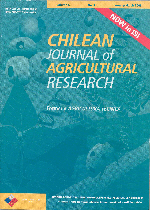
|
Agricultura Técnica
Instituto de Investigaciones Agropecuarias, INIA
ISSN: 0365-2807
EISSN: 0365-2807
Vol. 64, No. 3, 2004, pp. 314-318
|
 Bioline Code: at04035
Bioline Code: at04035
Full paper language: Spanish
Document type: Note
Document available free of charge
|
|
|
Agricultura Técnica, Vol. 64, No. 3, 2004, pp. 314-318
| en |
Identification of Phytophthora nicotianae, causal agent of tomato stem canker in Chile
Bruna, Alicia V. & Tobar, Gloria C.
Abstract
Tomatoes (Lycopersicon esculentum Mill.) are the main vegetable crop in Chile, with 18.000 ha cultivated, 88% of which are located between the V and VII Regions. In the last five years, a disease has frequently appeared in these regions, characterized by damping-off, stem cankers, rotting and death of roots, and brown concentric spots on fruit, and death of plants. Studies conducted in 32 fields located between the V and VII regions, demonstrated the presence of pathogenic isolates of Phytophthora nicotianae associated with diseased plants. The fungus was identified by morphological and biological characteristics and pathogenicity tests on plants and fruit. The identification was confirmed by the International Mycological Institute (CABI Bioscience) of the United Kingdom, which classified this Phytophthora in group II and identified it as A2 Phytophthora nicotianae Breda de Haan. This constitutes the first report of this pathogen affecting tomatoes in Chile.
Keywords
tomato, Phytophthora nicotianae, tomato stem canker, Lycopersicon esculentum
|
| |
| es |
Determinación de Phytophthora nicotianae, causante del cancro del tallo de tomate en Chile
Bruna, Alicia V. & Tobar, Gloria C.
Resumen
El tomate (Lycopersicon esculentum Mill.) es la principal hortaliza cultivada en el país, con 18.000 ha de superficie, concentrándose el 88% de la superficie productiva entre las regiones V y VII. En los últimos cinco años se ha presentado frecuentemente en estas regiones una enfermedad consistente en caída de plántulas en almácigo, lesiones o cancros en los tallos, pudrición y muerte de raíces, frutos con manchas pardas concéntricas y muerte de plantas. Estudios realizados en 32 predios ubicados entre las regiones V y VII demostraron la presencia de aislados patogénicos de Phytophthora nicotianae asociados a estas plantas enfermas. El hongo fue identificado de acuerdo a las características morfológicas, biológicas y a pruebas de patogenicidad en plantas y frutos de tomate. La identificación fue confirmada por el International Mycological Institute (CABI Bioscience) del Reino Unido, quien la clasificó en el grupo II y la identificó como A2 Phytophthora nicotianae Breda de Haan. Ésta constituye la primera identificación de este patógeno afectando tomates en Chile.
Palabras-clave
tomate, Phytophthora nicotianae, cancro del tallo del tomate, Lycopersicon esculentum.
|
| |
© Copyright 2004 - Instituto de Investigaciones Agropecuarias, INIA (Chile).
Alternative site location: http://www.inia.cl/at/agritec.htm
|
|
